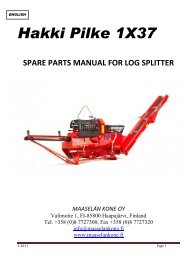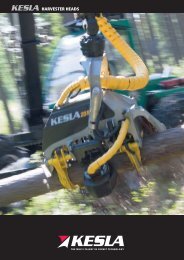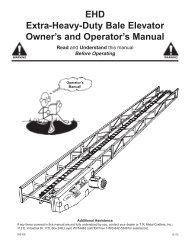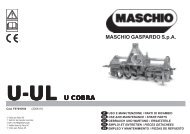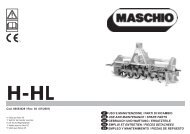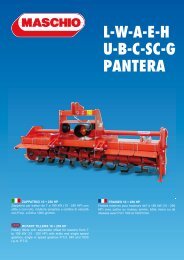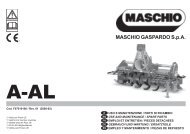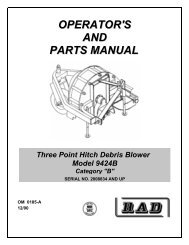G G - COBRA G - CONDOR - JS Woodhouse
G G - COBRA G - CONDOR - JS Woodhouse
G G - COBRA G - CONDOR - JS Woodhouse
- No tags were found...
Create successful ePaper yourself
Turn your PDF publications into a flip-book with our unique Google optimized e-Paper software.
ITALIANO ENGLISH DEUTSCH FRANÇAIS<br />
ESPAÑOL<br />
Se si devono sostituire le zappe, fare attenzione<br />
che le nuove assumano la posizione<br />
di quelle smontate (Fig. 22).<br />
Versione «<strong>COBRA</strong>»<br />
La versione a denti monta un rotore speciale<br />
a flange quadre con 4 denti per<br />
flangia e una barra livellatrice posteriore<br />
regolabile in altezza con appositi martinetti<br />
laterali (12 Fig. 1).<br />
Questo tipo di macchina è particolarmente<br />
indicato per la preparazione del letto<br />
di semina su terreni particolarmente tenaci<br />
e difficili o terreni non arati.<br />
In caso di sostituzione di tutti o anche<br />
soltanto di alcuni denti, è consigliabile<br />
effettuare lo smontaggio ed il rimontaggio<br />
di una dente per volta al fine di evitare<br />
errori di posizione.<br />
Versione «<strong>CONDOR</strong>»<br />
Questa versione monta un rotore speciale<br />
a denti fissati su supporti stampati in<br />
acciaio ad alta resistenza (15 Fig. 1).<br />
Può essere equipaggiata con lamiere livellatrici<br />
o con rullo posteriore.<br />
Questa macchina è indicata per preparare<br />
il letto di semina su terreni tenaci e<br />
sassosi.<br />
3.11 CAMBIO DI VELOCITÀ<br />
La macchina è equipaggiata di un cambio<br />
a leva a tre velocità (Fig. 23) che in<br />
relazione alla coppia di ingranaggi posizionati<br />
posteriormente può fornire due<br />
gamme differenti di valori di rotazione dei<br />
rotori portacoltelli.<br />
È molto utile per terreni non uniformi, in<br />
quanto facilita la lavorabilità del terreno<br />
mantenendo costante la velocità di avanzamento<br />
del trattore.<br />
Per cambiare velocità è necessario sfilare<br />
la coppiglia di sicurezza (1 Fig. 23),<br />
rimuovere l’asta (2 Fig. 23) che blocca in<br />
posizione la leva delle marce e quindi<br />
spostare la leva stessa nella selezione<br />
desiderata.<br />
Successivamente rimontare l’asta e la<br />
coppiglia di sicurezza.<br />
Se le velocità predisposte di serie non<br />
soddisfano la necessità di lavorazione,<br />
32<br />
If the hoe blades must be changed, remember<br />
to set the new blades in the<br />
same positions as the demounted ones<br />
(Fig. 22).<br />
«<strong>COBRA</strong>» Version<br />
The version with toothed rotor has a special<br />
square flange rotor fitted with four<br />
toothed rotor per flange and a rear leveling<br />
bar that can be adjusted in height with the<br />
appropriate lateral jacks (12 Fig. 1).<br />
This type of machine is particularly useful<br />
for preparing the seeding bed on particularly<br />
tough and difficult ground or on<br />
ground that has not been plowed.<br />
If all, or even just some, of the toothed<br />
rotor are to be replaced, it is advisable to<br />
strip and refit each toothed rotor singly in<br />
order to avoid positioning errors.<br />
«<strong>CONDOR</strong>» version<br />
This version is fitted with a special<br />
toothed rotor fastened to high resistance<br />
molded steel supports (15 Fig. 1).<br />
It could be fitted with skimmers or with a<br />
rear roller.<br />
This machine is indicated for preparing<br />
the sowing bed on tough and stony soil.<br />
3.11 GEARBOX<br />
The machine is equipped with a threespeed<br />
lever operated gearbox (Fig. 23)<br />
which can supply two different ranges of<br />
spinning values for the blade rotors in<br />
relation to the pair of gears installed at<br />
the rear.<br />
This is very useful on uneven ground<br />
since it makes the soil more workable by<br />
keeping the advancement speed of the<br />
tractor at a steady rate.<br />
To change the speed, remove the safety<br />
split pin (1 Fig. 23), remove the rod (2<br />
Fig. 23) that locks the gear lever in position<br />
and then move the lever itself to the<br />
desired position.<br />
Following this, fit the rod and safety split<br />
pin back in place.<br />
If the standard preset speeds fail to meet<br />
the soil-working requirements, the pair of<br />
gears can be inverted in order to obtain<br />
Wenn man die Hackmesser ersetzen<br />
muß, darauf achten, daß die neuen in der<br />
Position der ersetzen am Hackstern angebracht<br />
werden (Abb. 22).<br />
Ausführung «<strong>COBRA</strong>»<br />
In der Ausführung mit Zähnen ist ein<br />
Spezialläufer mit Viereckflanschen und<br />
4 Zähnen pro Flansch und eine hintere<br />
Planierstange, die durch dazu bestimmte<br />
Seitenwinden in der Höhe eingestellt<br />
werden kann, eingebaut (12 Abb. 1).<br />
Diese Maschine ist besonders für die Vorbereitung<br />
des Saatbeetes in besonders<br />
zähem und schwierigem oder ungepflügtem<br />
Erdreich geeignet.<br />
Falls alle oder auch nur ein Zähnen ersetzt<br />
werden mu•, wird empfohlen, nur<br />
ein Zähn auf einmal zu demontieren und<br />
wieder zu montieren, damit Positionierungsfehler<br />
vermieden werden.<br />
Ausführung «<strong>CONDOR</strong>»<br />
Diese Ausführung hat einen Spezialläufer<br />
mit Zähnen, die auf formgestanzten Lagerungen<br />
aus sehr widerstandsfähigem<br />
Stahl befestigt sind (15 Abb. 1).<br />
Kann mit Planierblechen oder rückwärtiger<br />
Walze ausgestattet sein.<br />
Diese Maschine ist für die Vorbereitung<br />
des Aussaatbetts auf festem und steinreichem<br />
Erdreich geeignet.<br />
3.11 WECHSELGETRIEBE<br />
Die Maschine ist mit einem Schalthebel<br />
mit drei Stellungen ausgestattet (Abb.<br />
23), der je nach den beiden Zahnrädern,<br />
die hinten positioniert sind, zwei unterschiedliche<br />
Drehzahlbereiche für die<br />
Rotation der Messertragerotoren liefern<br />
kann. Das ist auf unebenem Gelände<br />
sehr nützlich, weil es die Bearbeitung des<br />
Bodens vereinfacht und die Fahrgeschwindigkeit<br />
des Schleppers konstant<br />
gehalten werden kann.<br />
Um einen anderen Gang zu erhalten, den<br />
Sicherungssplint (1 Abb. 23) herausziehen,<br />
die Stange (2 Abb. 23) entfernen,<br />
mit der der Gangschalthebel blockiert<br />
wird, um den Hebel dann in die gewünschte<br />
Stellung zu bringen. Die Stange<br />
und den Sicherungssplint anschließend<br />
wieder montieren.<br />
Wenn die serienmäßig vorhandenen<br />
Gänge nicht den Arbeitsgegebenheiten<br />
entsprechen, kann man die beiden Zahn-<br />
En cas de remplacement des couteaux,<br />
veillez surtout à ce que les nouveaux<br />
couteaux occupent les positions de ceux<br />
démontés (Fig. 22).<br />
Version «<strong>COBRA</strong>»<br />
La version à dents prévoit un rotor spécial<br />
à brides carrées ayant 4 dents chacune<br />
et une barre de nivellement à hauteur<br />
réglable par des vérins latéraux ad<br />
hoc (12 Fig. 1).<br />
Ce type de machine est particuliérement<br />
approprié à la préparation du semis sur<br />
des terrains trés durs et difficiles ou sur<br />
des terrains non labourés.<br />
Lorsque vous remplacez toutes les dents<br />
ou certains d’entre elles, nous vous conseillons<br />
de démonter et de remonter une<br />
dent à la fois afin d’éviter de les positionner<br />
de maniére erronée.<br />
Version «<strong>CONDOR</strong>»<br />
Cette version dispose d’un rotor spécial<br />
à dents fixées sur des supports matricés<br />
en acier à résistance élevée (15 Fig. 1).<br />
Peut être équipée avec des tôles de mise<br />
à niveau ou avec un rouleau arrière.<br />
Cette machine est indiquée pour préparer<br />
le semis sur des terrains tenaces et<br />
caillouteux.<br />
3.11 BOITE DE VITESSES<br />
La machine est équipée d’une boîte à<br />
trois vitesses, avec commande par levier<br />
(Fig. 23). Suivant le couple d’engrenages<br />
placés à l’arrière, il peut fournir deux<br />
gammes différentes de valeurs de rotation<br />
des rotors porte-couteaux.<br />
C’est un outil très efficace sur les terrains<br />
irréguliers, puisqu’il facilite l’ameublissement<br />
du terrain, tout en maintenant<br />
constante la vitesse d’avancement du<br />
tracteur.<br />
Pour changer de vitesse il faut retirer la<br />
goupille de sécurité (1 Fig. 23), déposer<br />
la tige (2 Fig. 23) qui bloque le levier de<br />
vitesses pour pouvoir le déplacer sur la<br />
sélection désirée. Ensuite remonter la<br />
tige et la goupille de sécurité.<br />
Si les vitesses prévues de série ne répondent<br />
pas aux exigences de travail, il<br />
sera possible d’inverser le couple d’en-<br />
Cuando sustituimos azadillas respetar la<br />
posición de las azadillas desmontadas<br />
(Fig. 22).<br />
Versión «<strong>COBRA</strong>»<br />
La versión de dientes lleva un rotor especial<br />
de bridas cuadradas con 4 dientes<br />
por cada brida y una barra niveladora<br />
trasera con altura regulable mediante<br />
especiales gatos laterales (12 Fig. 1).<br />
Este tipo de máquina está particularmente<br />
indicado para la preparación del<br />
lechode siembra sobre terrenos muy<br />
compactos y dificiles o sobre terrenos no<br />
arados.<br />
En caso de sustitución de todos, o tan<br />
sólo de algunas, dientes, se aconseja<br />
desmontar y volver a montar las diente<br />
una a una para evitar errores de colocación<br />
de las mismas.<br />
Versión «<strong>CONDOR</strong>»<br />
Esta versión tiene montado un rotor de<br />
dientes, los cuales están fijados sobre<br />
soportes estampados de acero de alta<br />
resistencia (15 Fig. 1).<br />
Puede equiparse con planchas niveladoras<br />
o con rodillo posterior.<br />
Esta máquina es indicada para preparar<br />
el lecho de siembra en terrenos tenaces<br />
y pedregosos.<br />
3.11 CAMBIO DE<br />
VELOCIDAD<br />
La máquinas está equipada con un cambio<br />
de palanca de tres velocidades (Fig.<br />
23) que en base al par de engranajes emplazados<br />
en posición posterior puede suministrar<br />
dos diversas gamas de valores<br />
de rotación de los rotores porta-cuchillas.<br />
Es muy útil para terrenos no uniformes,<br />
ya que facilita el trabajo sobre el terreno,<br />
manteniendo constante la velocidad de<br />
marcha del tractor.<br />
Para cambiar velocidad es necesario extraer<br />
el pasador de seguridad (1 Fig. 23),<br />
quitar la varilla (2 Fig. 23) que bloquea<br />
en posición la palanca de las marchas y<br />
luego desplazar la palanca misma en la<br />
selección deseada.<br />
Luego volver a montar la varilla y el pasador<br />
de seguridad.<br />
Si las velocidades previstas no satisfacen<br />
las necesidades de trabajo, podemos



